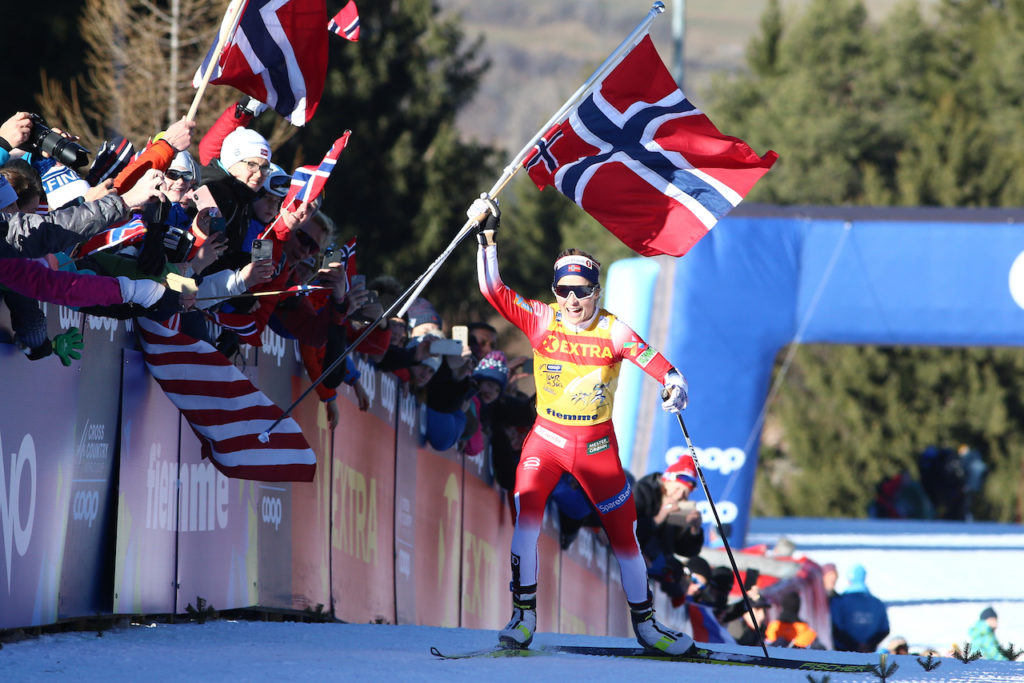As the Beijing 2022 Winter Olympic Games officially closed on Sunday. The land of the fjords is once again in pole position sitting at the top of the medal table, keeping Norway’s domination in the major winter sports events.
I’ll let you know if you have yet to hear of Norway. Please make no mistake. It’s one of the most prosperous countries per capita for the Winter Olympic sport since the inauguration of the Games in Chamonix 98 years ago.
So how do they do it? The Norwegian system is based on investment in grassroots sports. The emphasis is on participation. The Norwegians’ goal is to encourage and motivate all citizens to participate in sports as much as possible rather than having only a few elite athletes under state support.
With just 5.4 million people, Norway has won 16 medals in Beijing. It’s more than Great Britain, France, and Sweden combined, with 11 of them won by cross-country skiers.
This blog examines why Norway has been so successful in the Olympics and what lessons other nations can learn from them.
Suppose sports fans in Norway have been experiencing a fairytale-like time of top athletic performance. That is likely the case. Although, of course, China might’ve claimed the most gold medals at this year’s Olympics Games (including the historic moment when they topped the medal table). Still, Norway has managed to take home an unprecedented amount of Olympic glory in recent months.
The Norwegian newspaper VG analysed the number of golds won during this year’s Olympics and found Norway’s most successful Olympic nation per capita.
If we’re only considering gold medals, VG has compiled a list of the top 5 nations by population for the Summer and Winter Olympics. The basic premise of their analysis was that Norway is not just winning more than ten golds but achieving its goals in perfect harmony with its mission and values as an Olympic nation.
Norway has amassed 20 Olympic gold medals in just six months between the Tokyo summer and Winter Olympics in Beijing. Moreover, VG claims have ranked them among the best Olympic nations in terms of performance level compared to population size. Norway (20 gold – 5.4 million), ahead of Sweden (11 gold – 10.4 million), and the Netherlands (18 gold – 17.4 million inhabitants). The United States and China have both won 47 gold medals at the Summer and Winter Olympics. However, they must catch up when we consider their population’s size. https://www.vg.no/sport/i/Kz2l84/209-dager-20-gull-naa-er-norge-verdens-beste-olympiske-nasjon.
But how does this small Scandinavian country continually out-power much bigger nations like USA, Russia, and Sweden, more great skiing nations?
Norwegian success lies behind a well-structured system focused on fun from a young age, attracting 93% of youngsters. Dedication, excellence, commitment, and hard work lead to success.
They have created a culture where athletes can thrive and thrive without undue distraction from family life or other concerns (at least for athletes). This culture makes them so successful repeatedly— something that other countries would do well to emulate.
Norway has been at the forefront of winter sports related to the Olympics. As an avid cross-country skier, I know the number of Norwegians competing in such events.
The answer is simple. In Norway, it’s not about money and fame. Instead, it is about spirit and pride.
It’s about having a great team atmosphere and a culture that values individual success over numbers and being at the top of your game.
When your team has one more gold medal than everyone else, it doesn’t matter who you are or what your country calls you as long as you are good enough for your country.
Norwegian people are passionate about their sport and want to be a part of it. They love showing off their skills and, in turn, showing others around them that they can do it, too. This passion comes from within their community and results in the strong support of those who excel at their chosen sport. They are not looking for fame or money; they seek something far more valuable: inspiration and self-confidence.
Norway has produced several athletes on the level of Olympians, such as Ole Einar Bjørndalen, nicknamed the “King of Biathlon”. Marit Bjørgen, Bjørn Daehlie, Johan Grøttumbråten (1899-1983), Grete Waitz (1953-2011), Magnar Solberg. And many more who have won medals in different events most recently, Johannes Thingnes Bø, his brother Tarjei Bø, Vetle Sjaastad Christiansen, and Marte Olsbu Røseland in the Biathlon, Johannes Høsflot Klaebo, an extraordinary cross-country athlete, and Therese Johaug which was sensational by winning gold in the women’s mass start cross-country race on the final day of the Beijing Winter Olympics.
According to Tom Farrey, the Norwegian Youth program encourages young people to participate in non-competitive sports and sports for health, physical fitness, and well-being. It makes them more aware of their environment and the importance of environmental protection. He has been studying the subject for over a decade. In Norway, Farrey wrote recently in The New York Times, “93% of children in Norway grow up playing organised sports. Where costs are low, the economic barriers to entry are few. The team do not travel until the teenage years. And adults don’t start selecting the weak from the strong until children have grown into their bodies and interests. Then the most promising talents become the most competitive athletes globally, on a per-capita basis”.
And this is not all. Norway has invested in a scheme to keep most athletes within the industry when they retire from competing. They’ve set up a “Norwegian Youth in Sports Leadership Program” scheme. The program’s target group is 15-19 years old. It aims to provide young Norwegians with the opportunity to stay in sports after their career as athletes. As an example, one of the options is to recruit and develop a new generation of volunteers.
As a country, Norway has a very long, proud tradition of winter sports. Their achievements in the sport are phenomenal, especially in cross-country skiing. You always hear the Norwegians saying as a joke that there were born with skis on their feet. That explains the commitment and the love for winter sports.
It is essential to encourage and motivate all people to participate in sports to get the most out of them. Many people are highly motivated to pursue sports but need the proper framework, infrastructure, and support designed & tailored made for the community from the grassroots to the elite level.
This blog post will help you understand how Norway successfully reached its target and beyond. We hope you enjoyed the article, and if you have any other questions or concerns, don’t hesitate to contact us anytime!
[{"id":6849,"link":"https:\/\/roostertailsport.com\/2025\/01\/30\/sports-business-trends-2025-the-new-playbook-for-success\/","name":"sports-business-trends-2025-the-new-playbook-for-success","thumbnail":{"url":"https:\/\/roostertailsport.com\/wp-content\/uploads\/2025\/01\/DALL\u00b7E-2025-01-30-09.54.37-A-realistic-wide-size-digital-artwork-representing-key-topics-from-a-sports-business-blog.-The-image-includes_-1-A-person-holding-a-smartphone-stream.webp","alt":"Wide collage featuring a smartphone streaming soccer, a basketball player in action, an American football player, a Formula 1 car, and blockchain elements."},"title":"Sports Business Trends 2025: The New Playbook for Success","author":{"name":"Sid Bensalah","link":"https:\/\/roostertailsport.com\/author\/sid\/"},"date":"Jan 30, 2025","dateGMT":"2025-01-30 08:56:15","modifiedDate":"2025-01-30 10:22:44","modifiedDateGMT":"2025-01-30 09:22:44","commentCount":"0","commentStatus":"closed","categories":{"coma":"<a href=\"https:\/\/roostertailsport.com\/category\/sports-business\/\" rel=\"category tag\">Sports Business<\/a>","space":"<a href=\"https:\/\/roostertailsport.com\/category\/sports-business\/\" rel=\"category tag\">Sports Business<\/a>"},"taxonomies":{"post_tag":"<a href='https:\/\/roostertailsport.com\/tag\/caitlain-clark\/' rel='post_tag'>Caitlain Clark<\/a><a href='https:\/\/roostertailsport.com\/tag\/cryptocurrency\/' rel='post_tag'>Cryptocurrency<\/a><a href='https:\/\/roostertailsport.com\/tag\/formula1\/' rel='post_tag'>Formula1<\/a><a href='https:\/\/roostertailsport.com\/tag\/golf\/' rel='post_tag'>Golf<\/a><a href='https:\/\/roostertailsport.com\/tag\/innovation\/' rel='post_tag'>Innovation<\/a><a href='https:\/\/roostertailsport.com\/tag\/lionel-messi\/' rel='post_tag'>Lionel Messi<\/a><a href='https:\/\/roostertailsport.com\/tag\/liv\/' rel='post_tag'>LIV<\/a><a href='https:\/\/roostertailsport.com\/tag\/motorsports\/' rel='post_tag'>Motorsports<\/a><a href='https:\/\/roostertailsport.com\/tag\/nba\/' rel='post_tag'>NBA<\/a><a href='https:\/\/roostertailsport.com\/tag\/nft\/' rel='post_tag'>NFT<\/a><a href='https:\/\/roostertailsport.com\/tag\/pga\/' rel='post_tag'>PGA<\/a><a href='https:\/\/roostertailsport.com\/tag\/podcasts\/' rel='post_tag'>Podcasts<\/a><a href='https:\/\/roostertailsport.com\/tag\/simone-biles\/' rel='post_tag'>Simone Biles<\/a><a href='https:\/\/roostertailsport.com\/tag\/sports-broadcasting\/' rel='post_tag'>Sports Broadcasting<\/a><a href='https:\/\/roostertailsport.com\/tag\/sports-podcasts\/' rel='post_tag'>Sports Podcasts<\/a><a href='https:\/\/roostertailsport.com\/tag\/streaming\/' rel='post_tag'>Streaming<\/a><a href='https:\/\/roostertailsport.com\/tag\/technology\/' rel='post_tag'>Technology<\/a><a href='https:\/\/roostertailsport.com\/tag\/web3\/' rel='post_tag'>Web3<\/a>"},"readTime":{"min":4,"sec":6},"status":"publish","excerpt":""},{"id":6808,"link":"https:\/\/roostertailsport.com\/2024\/10\/13\/the-environmental-cost-of-sports-more-than-just-a-game\/","name":"the-environmental-cost-of-sports-more-than-just-a-game","thumbnail":{"url":"https:\/\/roostertailsport.com\/wp-content\/uploads\/2024\/10\/46.png","alt":"Ariel views a packed sports stadium surrounded by urban development and smog."},"title":"The Environmental Cost of Sports: More Than Just a Game","author":{"name":"Sid Bensalah","link":"https:\/\/roostertailsport.com\/author\/sid\/"},"date":"Oct 13, 2024","dateGMT":"2024-10-13 11:28:26","modifiedDate":"2024-10-13 12:28:31","modifiedDateGMT":"2024-10-13 11:28:31","commentCount":"0","commentStatus":"closed","categories":{"coma":"<a href=\"https:\/\/roostertailsport.com\/category\/uncategorized\/\" rel=\"category tag\">Uncategorized<\/a>","space":"<a href=\"https:\/\/roostertailsport.com\/category\/uncategorized\/\" rel=\"category tag\">Uncategorized<\/a>"},"taxonomies":{"post_tag":""},"readTime":{"min":7,"sec":29},"status":"publish","excerpt":""},{"id":6801,"link":"https:\/\/roostertailsport.com\/2024\/10\/07\/why-japanese-brands-are-leaving-olympic-ponsorships\/","name":"why-japanese-brands-are-leaving-olympic-ponsorships","thumbnail":{"url":"https:\/\/roostertailsport.com\/wp-content\/uploads\/2024\/10\/pexels-photo-236937-236937.jpg","alt":"Olympic Symbol Landmark"},"title":"Why Japanese Brands Are Leaving Olympic Sponsorships?","author":{"name":"Sid Bensalah","link":"https:\/\/roostertailsport.com\/author\/sid\/"},"date":"Oct 7, 2024","dateGMT":"2024-10-07 08:43:49","modifiedDate":"2024-10-13 10:17:01","modifiedDateGMT":"2024-10-13 09:17:01","commentCount":"0","commentStatus":"closed","categories":{"coma":"<a href=\"https:\/\/roostertailsport.com\/category\/uncategorized\/\" rel=\"category tag\">Uncategorized<\/a>","space":"<a href=\"https:\/\/roostertailsport.com\/category\/uncategorized\/\" rel=\"category tag\">Uncategorized<\/a>"},"taxonomies":{"post_tag":""},"readTime":{"min":4,"sec":17},"status":"publish","excerpt":""},{"id":6788,"link":"https:\/\/roostertailsport.com\/2024\/04\/08\/in-conversation-with-sailgp-racing-towards-sustainable-future\/","name":"in-conversation-with-sailgp-racing-towards-sustainable-future","thumbnail":{"url":"https:\/\/roostertailsport.com\/wp-content\/uploads\/2024\/07\/03A_RP4_5485-1.png","alt":"In Conversation with SailGP: Racing Towards a Sustainable Future"},"title":"In Conversation with SailGP: Racing Towards a Sustainable Future","author":{"name":"Sid Bensalah","link":"https:\/\/roostertailsport.com\/author\/sid\/"},"date":"Apr 8, 2024","dateGMT":"2024-04-08 07:25:00","modifiedDate":"2024-07-11 09:26:22","modifiedDateGMT":"2024-07-11 08:26:22","commentCount":"0","commentStatus":"closed","categories":{"coma":"<a href=\"https:\/\/roostertailsport.com\/category\/uncategorized\/\" rel=\"category tag\">Uncategorized<\/a>","space":"<a href=\"https:\/\/roostertailsport.com\/category\/uncategorized\/\" rel=\"category tag\">Uncategorized<\/a>"},"taxonomies":{"post_tag":""},"readTime":{"min":4,"sec":20},"status":"publish","excerpt":""},{"id":6707,"link":"https:\/\/roostertailsport.com\/2024\/03\/07\/biodiversity-preservation-a-conversation-with-vikram-krishna\/","name":"biodiversity-preservation-a-conversation-with-vikram-krishna","thumbnail":{"url":"https:\/\/roostertailsport.com\/wp-content\/uploads\/2024\/03\/Preserving-Biodiversity.-A-Conversation-with-Vikram-Krishna-of-Sacred-Groves.jpg","alt":"Preserving Biodiversity: A Conversation with Vikram Krishna of Sacred Groves"},"title":"Biodiversity Preservation: A Conversation with Vikram Krishna.","author":{"name":"Sid Bensalah","link":"https:\/\/roostertailsport.com\/author\/sid\/"},"date":"Mar 7, 2024","dateGMT":"2024-03-07 17:02:14","modifiedDate":"2024-03-08 17:21:07","modifiedDateGMT":"2024-03-08 16:21:07","commentCount":"0","commentStatus":"closed","categories":{"coma":"<a href=\"https:\/\/roostertailsport.com\/category\/biodiversity\/\" rel=\"category tag\">Biodiversity<\/a>, <a href=\"https:\/\/roostertailsport.com\/category\/conservation\/\" rel=\"category tag\">Conservation<\/a>, <a href=\"https:\/\/roostertailsport.com\/category\/sustainability\/\" rel=\"category tag\">Sustainability<\/a>","space":"<a href=\"https:\/\/roostertailsport.com\/category\/biodiversity\/\" rel=\"category tag\">Biodiversity<\/a> <a href=\"https:\/\/roostertailsport.com\/category\/conservation\/\" rel=\"category tag\">Conservation<\/a> <a href=\"https:\/\/roostertailsport.com\/category\/sustainability\/\" rel=\"category tag\">Sustainability<\/a>"},"taxonomies":{"post_tag":"<a href='https:\/\/roostertailsport.com\/tag\/biodiversity\/' rel='post_tag'>Biodiversity<\/a><a href='https:\/\/roostertailsport.com\/tag\/conservation\/' rel='post_tag'>Conservation<\/a><a href='https:\/\/roostertailsport.com\/tag\/environmental-impact\/' rel='post_tag'>Environmental Impact<\/a><a href='https:\/\/roostertailsport.com\/tag\/nature-conservation\/' rel='post_tag'>Nature Conservation<\/a><a href='https:\/\/roostertailsport.com\/tag\/pre-zero-sports-talk\/' rel='post_tag'>Pre-Zero Sports Talk<\/a><a href='https:\/\/roostertailsport.com\/tag\/sports-industry\/' rel='post_tag'>Sports Industry<\/a><a href='https:\/\/roostertailsport.com\/tag\/sustainable-sports\/' rel='post_tag'>Sustainable Sports<\/a>"},"readTime":{"min":7,"sec":4},"status":"publish","excerpt":""},{"id":6680,"link":"https:\/\/roostertailsport.com\/2024\/03\/06\/strawberry-hotels-pioneering-sustainable-hospitality\/","name":"strawberry-hotels-pioneering-sustainable-hospitality","thumbnail":{"url":"https:\/\/roostertailsport.com\/wp-content\/uploads\/2024\/03\/Stockholm-City.png","alt":"Strawberry Hotels - Pioneering Sustainability in the Hospitality Landscape."},"title":"Strawberry Hotels: Pioneering Sustainable Hospitality.","author":{"name":"Sid Bensalah","link":"https:\/\/roostertailsport.com\/author\/sid\/"},"date":"Mar 6, 2024","dateGMT":"2024-03-06 18:21:17","modifiedDate":"2024-03-09 10:27:06","modifiedDateGMT":"2024-03-09 09:27:06","commentCount":"0","commentStatus":"closed","categories":{"coma":"<a href=\"https:\/\/roostertailsport.com\/category\/hospitality-industry\/\" rel=\"category tag\">Hospitality Industry<\/a>, <a href=\"https:\/\/roostertailsport.com\/category\/sustainability\/\" rel=\"category tag\">Sustainability<\/a>","space":"<a href=\"https:\/\/roostertailsport.com\/category\/hospitality-industry\/\" rel=\"category tag\">Hospitality Industry<\/a> <a href=\"https:\/\/roostertailsport.com\/category\/sustainability\/\" rel=\"category tag\">Sustainability<\/a>"},"taxonomies":{"post_tag":"<a href='https:\/\/roostertailsport.com\/tag\/climate-change\/' rel='post_tag'>Climate Change<\/a><a href='https:\/\/roostertailsport.com\/tag\/community\/' rel='post_tag'>Community<\/a><a href='https:\/\/roostertailsport.com\/tag\/hospitality-industry\/' rel='post_tag'>Hospitality Industry<\/a><a href='https:\/\/roostertailsport.com\/tag\/hotels\/' rel='post_tag'>Hotels<\/a><a href='https:\/\/roostertailsport.com\/tag\/impact\/' rel='post_tag'>Impact<\/a><a href='https:\/\/roostertailsport.com\/tag\/sports-industry\/' rel='post_tag'>Sports Industry<\/a><a href='https:\/\/roostertailsport.com\/tag\/sustainable-hospitality\/' rel='post_tag'>Sustainable Hospitality<\/a><a href='https:\/\/roostertailsport.com\/tag\/travel\/' rel='post_tag'>Travel<\/a>"},"readTime":{"min":7,"sec":11},"status":"publish","excerpt":""},{"id":6602,"link":"https:\/\/roostertailsport.com\/2024\/01\/14\/sports-business-trends-2024-peak-valuations\/","name":"sports-business-trends-2024-peak-valuations","thumbnail":{"url":"https:\/\/roostertailsport.com\/wp-content\/uploads\/2024\/01\/Sports-Business-Trends-2024.png","alt":"Unconventional sports league challenges established PGA norms."},"title":"Sports Business Trends 2024","author":{"name":"Sid Bensalah","link":"https:\/\/roostertailsport.com\/author\/sid\/"},"date":"Jan 14, 2024","dateGMT":"2024-01-14 19:33:32","modifiedDate":"2024-02-15 10:03:28","modifiedDateGMT":"2024-02-15 09:03:28","commentCount":"0","commentStatus":"closed","categories":{"coma":"<a href=\"https:\/\/roostertailsport.com\/category\/sports-business\/\" rel=\"category tag\">Sports Business<\/a>, <a href=\"https:\/\/roostertailsport.com\/category\/sustainability\/\" rel=\"category tag\">Sustainability<\/a>, <a href=\"https:\/\/roostertailsport.com\/category\/technology\/\" rel=\"category tag\">Technology<\/a>","space":"<a href=\"https:\/\/roostertailsport.com\/category\/sports-business\/\" rel=\"category tag\">Sports Business<\/a> <a href=\"https:\/\/roostertailsport.com\/category\/sustainability\/\" rel=\"category tag\">Sustainability<\/a> <a href=\"https:\/\/roostertailsport.com\/category\/technology\/\" rel=\"category tag\">Technology<\/a>"},"taxonomies":{"post_tag":""},"readTime":{"min":7,"sec":48},"status":"publish","excerpt":""},{"id":6555,"link":"https:\/\/roostertailsport.com\/2023\/12\/18\/cop28-navigating-the-fossil-fuel-exodus\/","name":"cop28-navigating-the-fossil-fuel-exodus","thumbnail":{"url":"https:\/\/roostertailsport.com\/wp-content\/uploads\/2023\/12\/UN-COP28-Dubai-UAE-.png","alt":"UN COP28 Dubai"},"title":"COP28: Navigating the Fossil Fuel Exodus","author":{"name":"Sid Bensalah","link":"https:\/\/roostertailsport.com\/author\/sid\/"},"date":"Dec 18, 2023","dateGMT":"2023-12-18 20:16:04","modifiedDate":"2023-12-19 13:37:43","modifiedDateGMT":"2023-12-19 12:37:43","commentCount":"0","commentStatus":"closed","categories":{"coma":"<a href=\"https:\/\/roostertailsport.com\/category\/environment\/\" rel=\"category tag\">Environment<\/a>, <a href=\"https:\/\/roostertailsport.com\/category\/sustainability\/\" rel=\"category tag\">Sustainability<\/a>, <a href=\"https:\/\/roostertailsport.com\/category\/united-nations-climate-change\/\" rel=\"category tag\">United Nations Climate Change<\/a>","space":"<a href=\"https:\/\/roostertailsport.com\/category\/environment\/\" rel=\"category tag\">Environment<\/a> <a href=\"https:\/\/roostertailsport.com\/category\/sustainability\/\" rel=\"category tag\">Sustainability<\/a> <a href=\"https:\/\/roostertailsport.com\/category\/united-nations-climate-change\/\" rel=\"category tag\">United Nations Climate Change<\/a>"},"taxonomies":{"post_tag":"<a href='https:\/\/roostertailsport.com\/tag\/climateaction\/' rel='post_tag'>#ClimateAction<\/a><a href='https:\/\/roostertailsport.com\/tag\/cop28\/' rel='post_tag'>#COP28<\/a><a href='https:\/\/roostertailsport.com\/tag\/netzero-2\/' rel='post_tag'>#NetZero<\/a><a href='https:\/\/roostertailsport.com\/tag\/sustainability-2\/' rel='post_tag'>#Sustainability<\/a>"},"readTime":{"min":6,"sec":36},"status":"publish","excerpt":""},{"id":6522,"link":"https:\/\/roostertailsport.com\/2023\/09\/06\/athletes-equity-players-sports-business\/","name":"athletes-equity-players-sports-business","thumbnail":{"url":"https:\/\/roostertailsport.com\/wp-content\/uploads\/2023\/09\/The-Business-of-Sports-Where-Strategy-Meets-the-Pitch.png","alt":"Celebrating the Intersection of Sports and Business"},"title":"The Messi Effect: How Athletes Are Becoming Equity Players.","author":{"name":"Sid Bensalah","link":"https:\/\/roostertailsport.com\/author\/sid\/"},"date":"Sep 6, 2023","dateGMT":"2023-09-06 11:35:50","modifiedDate":"2023-09-06 13:36:38","modifiedDateGMT":"2023-09-06 12:36:38","commentCount":"0","commentStatus":"closed","categories":{"coma":"<a href=\"https:\/\/roostertailsport.com\/category\/athlete-influence\/\" rel=\"category tag\">Athlete Influence<\/a>, <a href=\"https:\/\/roostertailsport.com\/category\/entrepreneurship\/\" rel=\"category tag\">Entrepreneurship<\/a>, <a href=\"https:\/\/roostertailsport.com\/category\/sports-business\/\" rel=\"category tag\">Sports Business<\/a>","space":"<a href=\"https:\/\/roostertailsport.com\/category\/athlete-influence\/\" rel=\"category tag\">Athlete Influence<\/a> <a href=\"https:\/\/roostertailsport.com\/category\/entrepreneurship\/\" rel=\"category tag\">Entrepreneurship<\/a> <a href=\"https:\/\/roostertailsport.com\/category\/sports-business\/\" rel=\"category tag\">Sports Business<\/a>"},"taxonomies":{"post_tag":"<a href='https:\/\/roostertailsport.com\/tag\/content-creator\/' rel='post_tag'>content creator<\/a><a href='https:\/\/roostertailsport.com\/tag\/equity-player\/' rel='post_tag'>Equity Player<\/a><a href='https:\/\/roostertailsport.com\/tag\/messi-effect\/' rel='post_tag'>Messi Effect<\/a><a href='https:\/\/roostertailsport.com\/tag\/social-media\/' rel='post_tag'>Social Media<\/a><a href='https:\/\/roostertailsport.com\/tag\/stakeholder\/' rel='post_tag'>stakeholder<\/a>"},"readTime":{"min":8,"sec":30},"status":"publish","excerpt":""},{"id":6492,"link":"https:\/\/roostertailsport.com\/2023\/08\/29\/empowering-change-through-sustainable-activewear\/","name":"empowering-change-through-sustainable-activewear","thumbnail":{"url":"https:\/\/roostertailsport.com\/wp-content\/uploads\/2023\/08\/franziska-Mesche-Tripulse-founder-CEO-1.jpg","alt":"Franziska Mesche, Founder and CEO of Tripulse, showcasing Sustainable Activewear."},"title":"Empowering Change Through Sustainable Activewear.","author":{"name":"Sid Bensalah","link":"https:\/\/roostertailsport.com\/author\/sid\/"},"date":"Aug 29, 2023","dateGMT":"2023-08-29 07:00:59","modifiedDate":"2024-03-07 08:01:43","modifiedDateGMT":"2024-03-07 07:01:43","commentCount":"0","commentStatus":"open","categories":{"coma":"<a href=\"https:\/\/roostertailsport.com\/category\/environment\/\" rel=\"category tag\">Environment<\/a>, <a href=\"https:\/\/roostertailsport.com\/category\/sport-technology\/\" rel=\"category tag\">Sport & Technology<\/a>, <a href=\"https:\/\/roostertailsport.com\/category\/sustainability\/\" rel=\"category tag\">Sustainability<\/a>, <a href=\"https:\/\/roostertailsport.com\/category\/sustainable-fashion\/\" rel=\"category tag\">Sustainable Fashion<\/a>","space":"<a href=\"https:\/\/roostertailsport.com\/category\/environment\/\" rel=\"category tag\">Environment<\/a> <a href=\"https:\/\/roostertailsport.com\/category\/sport-technology\/\" rel=\"category tag\">Sport & Technology<\/a> <a href=\"https:\/\/roostertailsport.com\/category\/sustainability\/\" rel=\"category tag\">Sustainability<\/a> <a href=\"https:\/\/roostertailsport.com\/category\/sustainable-fashion\/\" rel=\"category tag\">Sustainable Fashion<\/a>"},"taxonomies":{"post_tag":"<a href='https:\/\/roostertailsport.com\/tag\/activewear-innovation\/' rel='post_tag'>Activewear Innovation<\/a>"},"readTime":{"min":4,"sec":11},"status":"publish","excerpt":""},{"id":6348,"link":"https:\/\/roostertailsport.com\/2023\/08\/02\/fih-driving-sustainable-change-in-hockey\/","name":"fih-driving-sustainable-change-in-hockey","thumbnail":{"url":"https:\/\/roostertailsport.com\/wp-content\/uploads\/2023\/08\/Hockey-Sport-Action-on-the-turf-womens-game.png","alt":"Women's Hockey Sport in Action: Exciting moments on the turf!"},"title":"FIH: Driving Sustainable Change in Hockey.","author":{"name":"Sid Bensalah","link":"https:\/\/roostertailsport.com\/author\/sid\/"},"date":"Aug 2, 2023","dateGMT":"2023-08-02 14:57:59","modifiedDate":"2023-08-02 16:22:07","modifiedDateGMT":"2023-08-02 15:22:07","commentCount":"0","commentStatus":"closed","categories":{"coma":"<a href=\"https:\/\/roostertailsport.com\/category\/environment\/\" rel=\"category tag\">Environment<\/a>, <a href=\"https:\/\/roostertailsport.com\/category\/olympics\/\" rel=\"category tag\">Olympics<\/a>, <a href=\"https:\/\/roostertailsport.com\/category\/sports-governance\/\" rel=\"category tag\">Sports Governance<\/a>, <a href=\"https:\/\/roostertailsport.com\/category\/sustainability\/\" rel=\"category tag\">Sustainability<\/a>","space":"<a href=\"https:\/\/roostertailsport.com\/category\/environment\/\" rel=\"category tag\">Environment<\/a> <a href=\"https:\/\/roostertailsport.com\/category\/olympics\/\" rel=\"category tag\">Olympics<\/a> <a href=\"https:\/\/roostertailsport.com\/category\/sports-governance\/\" rel=\"category tag\">Sports Governance<\/a> <a href=\"https:\/\/roostertailsport.com\/category\/sustainability\/\" rel=\"category tag\">Sustainability<\/a>"},"taxonomies":{"post_tag":""},"readTime":{"min":3,"sec":32},"status":"publish","excerpt":""},{"id":6302,"link":"https:\/\/roostertailsport.com\/2023\/06\/10\/climate-change-athlete-activism-sports-sustainability\/","name":"climate-change-athlete-activism-sports-sustainability","thumbnail":{"url":"https:\/\/roostertailsport.com\/wp-content\/uploads\/2023\/06\/Climate-Change-Image-by-Gerd-Altmann-from-Pixabay.jpg","alt":"The Impact of Climate Change on Sports and Athlete Activism for Sustainability."},"title":"Climate Change & Athlete Activism: Sports Sustainability.","author":{"name":"Sid Bensalah","link":"https:\/\/roostertailsport.com\/author\/sid\/"},"date":"Jun 10, 2023","dateGMT":"2023-06-10 16:11:58","modifiedDate":"2023-08-11 07:30:15","modifiedDateGMT":"2023-08-11 06:30:15","commentCount":"0","commentStatus":"closed","categories":{"coma":"<a href=\"https:\/\/roostertailsport.com\/category\/athlete-advocacy\/\" rel=\"category tag\">Athlete Advocacy<\/a>, <a href=\"https:\/\/roostertailsport.com\/category\/coaching\/\" rel=\"category tag\">Coaching<\/a>, <a href=\"https:\/\/roostertailsport.com\/category\/environment\/\" rel=\"category tag\">Environment<\/a>, <a href=\"https:\/\/roostertailsport.com\/category\/olympics\/\" rel=\"category tag\">Olympics<\/a>, <a href=\"https:\/\/roostertailsport.com\/category\/sustainability\/\" rel=\"category tag\">Sustainability<\/a>, <a href=\"https:\/\/roostertailsport.com\/category\/winter-sports\/\" rel=\"category tag\">Winter Sports<\/a>","space":"<a href=\"https:\/\/roostertailsport.com\/category\/athlete-advocacy\/\" rel=\"category tag\">Athlete Advocacy<\/a> <a href=\"https:\/\/roostertailsport.com\/category\/coaching\/\" rel=\"category tag\">Coaching<\/a> <a href=\"https:\/\/roostertailsport.com\/category\/environment\/\" rel=\"category tag\">Environment<\/a> <a href=\"https:\/\/roostertailsport.com\/category\/olympics\/\" rel=\"category tag\">Olympics<\/a> <a href=\"https:\/\/roostertailsport.com\/category\/sustainability\/\" rel=\"category tag\">Sustainability<\/a> <a href=\"https:\/\/roostertailsport.com\/category\/winter-sports\/\" rel=\"category tag\">Winter Sports<\/a>"},"taxonomies":{"post_tag":""},"readTime":{"min":6,"sec":15},"status":"publish","excerpt":""}]

